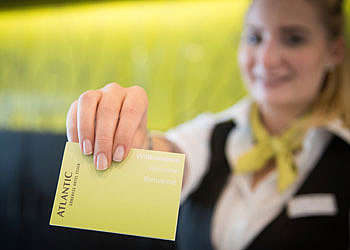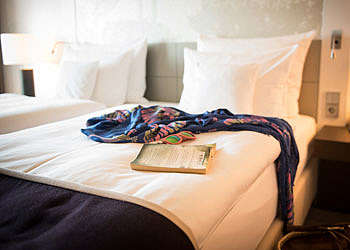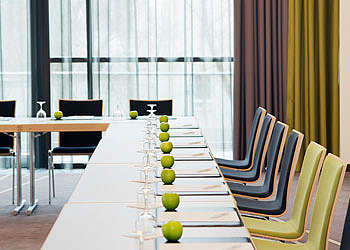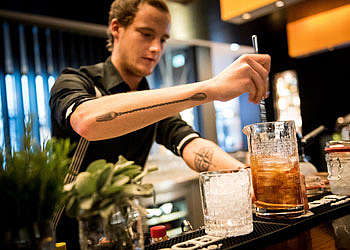Must See´s
Which you shouldn’t miss at any cost!
There’s hardly a cliché about the “Ruhr Region” of the past that applies to the spirit and life in the Ruhr Metropolis today. Not only has the Ruhr become one of the cleanest rivers in Europe—by decommissioning and giving a cultural renaissance to numerous old industrial sites, a complete cultural landscape has grown up here that’s almost unique.
Grugapark
The green lung of Essen.
Grugapark is probably one of the most unforgettable surprises in the Ruhr Metropolis. For if you think that this is a straightforward city park, you’re way off the mark! Although Grugapark lies in the middle of the Rüttenscheid, it takes up a whopping 65 hectares. Enormous meadows surrounded by old trees alternate with wonderful flowerbeds full of rare plants. The park originated from the Großen Ruhrländischen Gartenbauausstellung (GRUGA, or “great horticultural exhibition of the Ruhr area” in English, ) in 1929. Today it’s one of the most beautiful and greenest nature parks in Europe. Besides magnificent flowers and plants, the park contains a petting zoo, beach volleyball courts, an open-air museum, grilling stations, areas of water, adventure playgrounds, a pony farm, and much more! And you must get a look at the Essen Ronald McDonald House, designed according to designs by Friedensreich Hundertwasser.
Baldeneysee
The district’s most beautiful local recreation area.
We could write a novel about the leisure-time activities around the Baldeneysee. Dammed as a water reservoir in 1931, this lake of 2.7 m2 is a wonderful local recreation area that is well known far beyond the borders of Essen. The 14.7-km lap around the lake on well-maintained trails can be traversed on foot, with inline skates, or with a bicycle. For short or long breaks in the meantime, you can naturally find lots of restaurants and beer gardens. For a less strenuous trip, you can discover the Baldeneysee by boat with the “White Fleet”. Either by a tour around the lake or by setting off for the “big cruise” to the neighbouring city of Mülheim. To give you that “lake feeling”, there are rowing clubs around its banks, as well as schools for sailing and surfing. Once a year, the best German sailors meet here for the largest German inland lake regatta, the Essener Woche. A special highlight is the Seaside Beach Baldeney, a beach club with a sandy beach, palms, a cocktail bar, beach volleyball courts, and much more. High on the green hills around the lake towers the Villa Hügel, the residence of the Krupp industrial family until the 1940s. And a trip with a little steam locomotive nostalgia cannot be missed, especially in the summer months: the Herspertalbahn (Hespertal Railway). The wonderful route begins at the old Kupferdreh train station and continues along the Baldeneysee until the premises of the former Pörtingssiepen coal mine. And naturally, the Baldeneysee is a stop on the Essen city tours.
Schloss Borbeck
Baroque views in a wonderful park landscape.
A short trip to Essen Borbeck is definitely worth it, for you’ll be rewarded with a view of the beautiful Borbeck castle. The baroque moated castle was the preferred residence of the Essen abbesses beginning in the 14th century. Today, it’s a meeting place: you can visit concerts, exhibitions, seminars and meetings, take courses in art, dance or music, dine, or get married. The renaissance construction, which the abbess Franziska Christine had expanded in 1744 to include baroque elements, surrounds a magnificent park in the English landscape style. One glance at the green spaces will convince you that this is a special park: its origins can be traced back to the 16th century. This means that it’s not only the oldest park in the city by far, but historians believe it to be one of the oldest in the entire Rhineland. When the weather’s nice, you can stroll through its beautiful 42-hectare grounds.
The old synagogue
Discover Jewish culture.
It was once one of the most significant examples of Jewish architecture and is still one of the largest and most freestanding synagogues in Europe: the Essen Synagogue. Built from 1911–13, its interior was largely destroyed in the pogrom night of 1938. After the war, it served as a memorial and political-historical documentation forum. After extensive reconstruction work, it became home to the “House of Jewish Culture” in 2010, and has become a unique place in which one can learn what Jewish life is all about. The encounter with diverse aspects of living Jewish culture—once upon a time and today—forms a balanced programme along with memory and history. Five exhibits present the history of the Jewish community in Essen, the history of the house, the source of Jewish traditions, Jewish festivals, and the Jewish way of life. It’s worth a visit!
Essener DOM & Domschatzkammer
Important, priceless works of art
In the middle of Essen’s city centre is the Essener Dom, the catholic cathedral of the Ruhr Bishopric Essen, newly built in 1958. By 850, the noble Altfrid, later Bishop of Hildesheim, founded a convent here that was one of the most outstanding religious institutions for women during the Middle Ages. This convent had its heyday in the 10th and 11th centuries and was one of the three greatest family convents of the Ottonian dynasty. What will surprise you is that the cathedral’s “Schatzkammer” (treasure room) houses numerous world-famous and significant works of art of inestimable value. These include the Sword of Essen associated with Otto the Great, and the Crown of Essen, the oldest fleur-de-lis crown in the world. Two of the most important works of art remain in the cathedral: The Golden Madonna, the oldest three-dimensional image of Mary in the world, and the Ruhr Region’s greatest artistic treasure. The figure of Mary, which dates from 980 AD, is still a distinguished image of grace and stands in the left side aisle. The seven-armed candelabra also remains in the cathedral. It is the oldest existing seven-armed candelabra of Christendom and was created in 1000 using a hollow bronze casting. A visit to the cathedral and its Schatzkammer should be on the itinerary of every city tour in the Ruhr Region.






